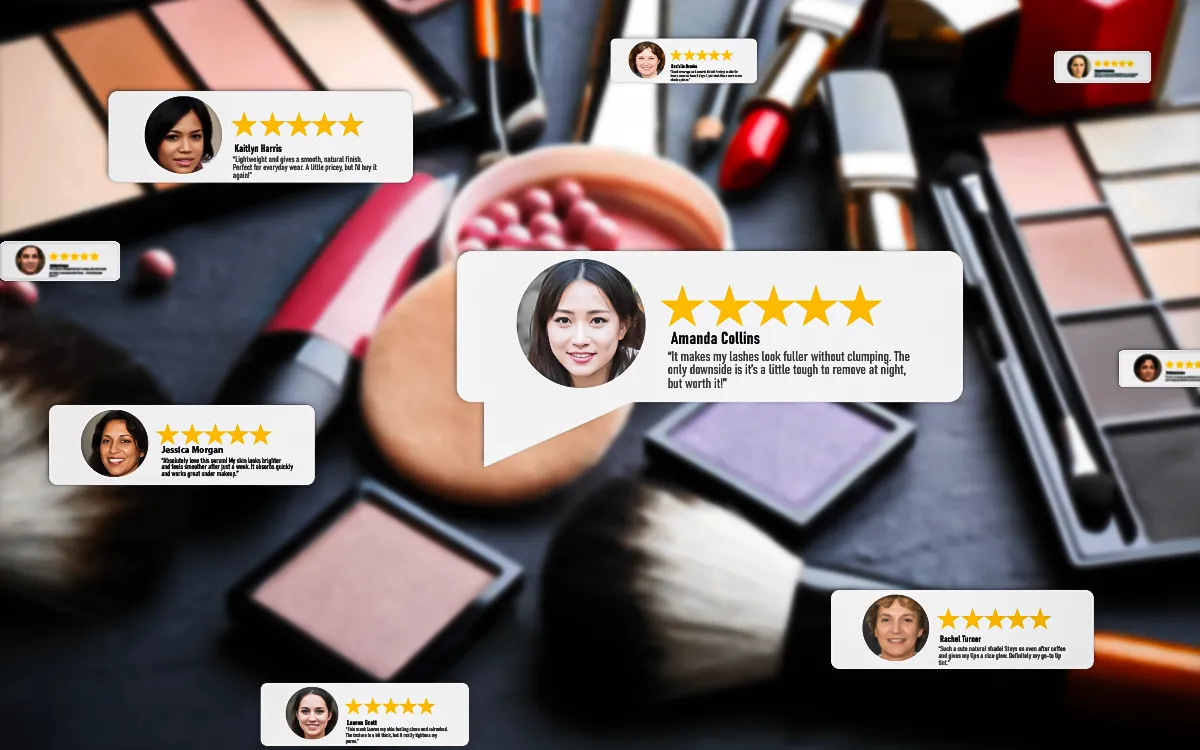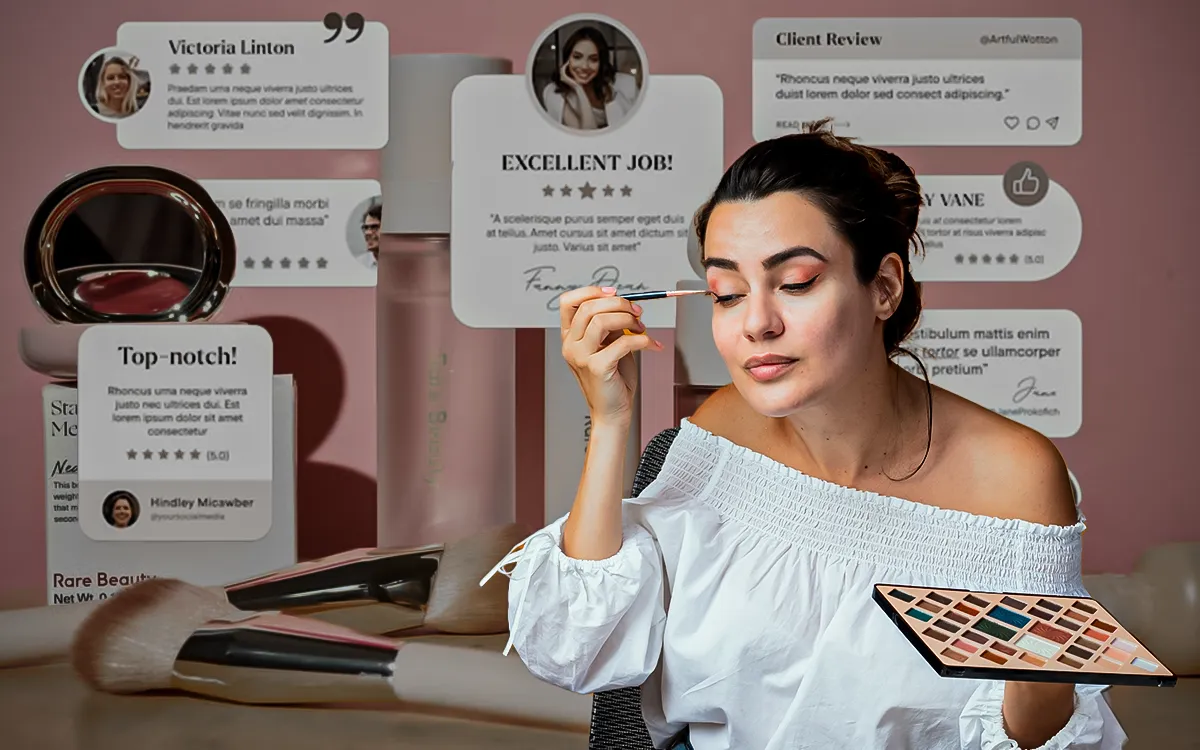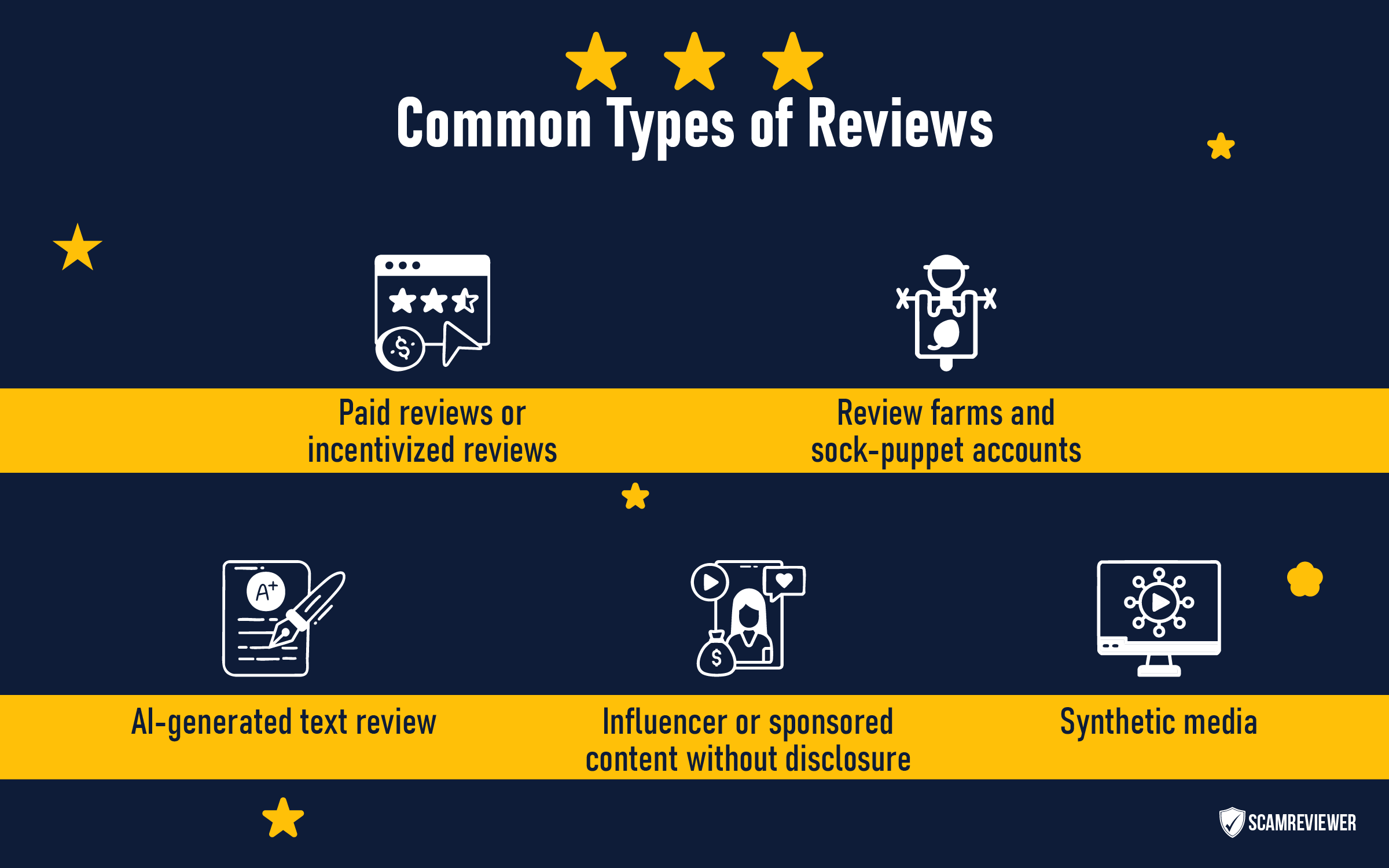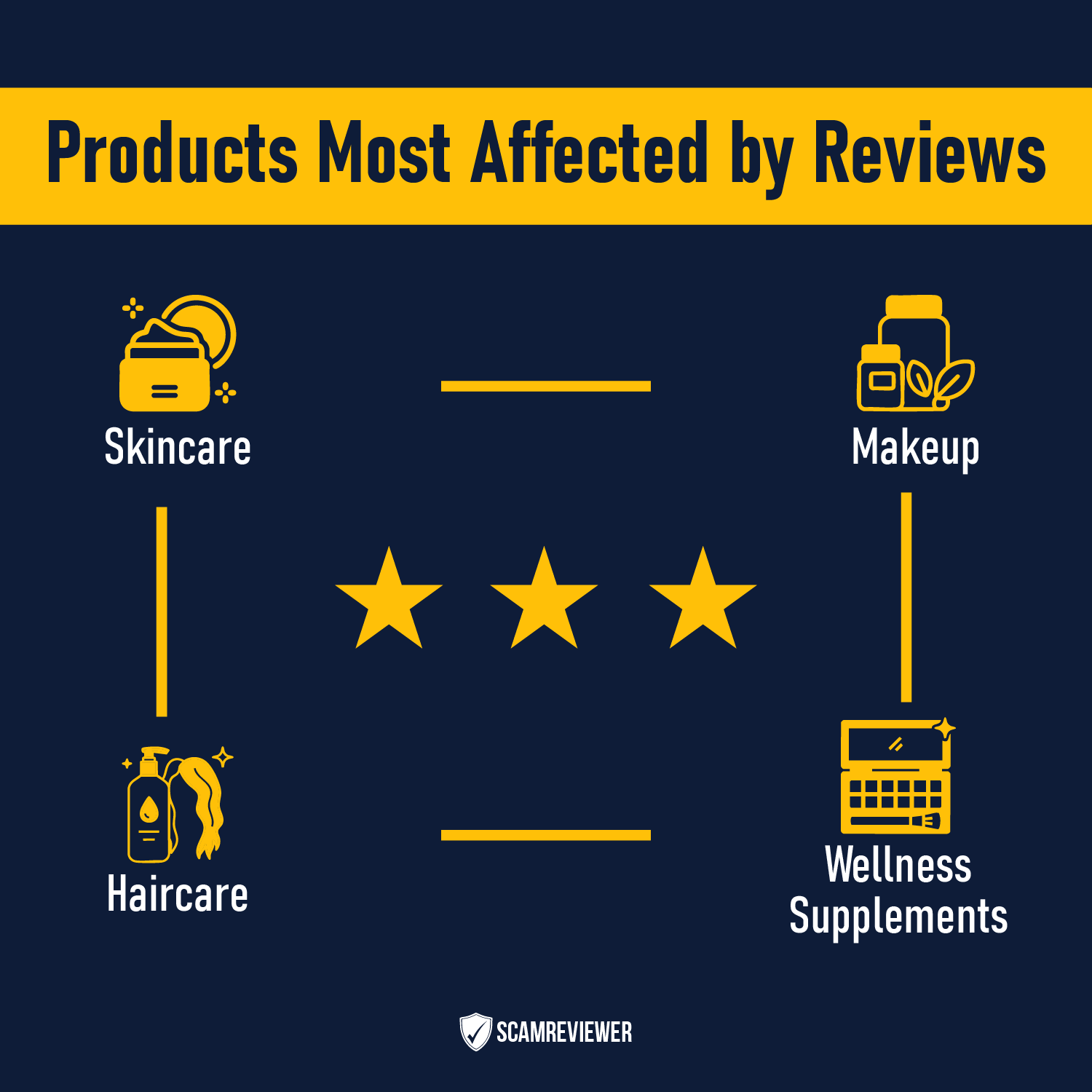How Fake Beauty Reviews Drain Millions from Shoppers

Purchasing a highly rated skincare serum for $60, only to later realize that the five-star reviews were fabricated, is a growing reality for many consumers in today’s online beauty marketplace. With bold claims of flawless skin and instant results, fake beauty reviews have emerged as one of the most misleading and costly challenges in modern e-commerce.
Studies show that around 30% of all online reviews are fake, and the beauty industry is among the hardest hit. On Amazon alone, at least 5% of beauty product reviews are suspected to be AI-generated, while independent research places the figure much higher, sometimes up to 43% across categories.
Shoppers are noticing. A recent survey revealed that 82% of consumers encountered a fake online review in the past year, while 74% admitted they often can’t tell whether feedback is genuine. This growing crisis in online review fraud in beauty is draining millions from wallets worldwide and eroding trust in legitimate brands.
In this article, you’ll discover the true cost of fake reviews, how to spot them before you buy, the steps regulators are taking, and the looming risks as AI makes deception even more convincing.
What Are Fake Beauty Reviews?

Today, reviews function as the modern form of word-of-mouth, yet the beauty and wellness industry has increasingly become a focal point for deceptive practices.
Fake cosmetic reviews and fake wellness product reviews are purposely created for the purpose of misleading consumers to spend their money on products that may be overpriced, ineffective, or even harmful.
This form of dishonesty is part of a complex web of beauty and wellness scams, causing consumers to lose millions of dollars every year.
Common Forms of Reviews

Fake beauty reviews come in many different shapes, forms, and sizes that do not follow one set pattern, which makes them look standard and real.
- Paid reviews or incentivized reviews: Most sellers provide products to consumers free of charge or at a discounted price in exchange for a positive review, but they will often describe this content as an unbiased or disinterested review.
- Review farms and sock-puppet accounts: Coordinated groups generate hundreds of fake accounts to submit fake praise about product listings.
- AI-generated text review: With generative AI, bad actors can produce fake text reviews that are entirely persuasive but appear to have been written naturally.
- Influencer or sponsored content without disclosure: Social media influencers can promote products without disclosing to consumers that they were paid to do so, which puts a barrier to what is marketing and what is a real opinion.
- Synthetic media: Edited photos, staged unboxing videos, and modified “before-and-after” pictures are increasingly being used as evidence of effectiveness.
Why are fake cosmetic reviews hard to detect?
It’s not as simple as a lot of buyers believe it is to identify these fraudulent strategies. While many platforms try to prevent fraud, fake reviews will always evade anti-counterfeiting agreements
- Copying language and templated reviews: Fraudsters use the same language across different products, making the feedback appear the same, albeit fake, in a believe it or not type of way.
- Overuse of “verified purchase” labels: A label meant to inspire customer trust is sometimes abused by buying a product in bulk or refunding the product post-review, thereby creating false legitimacy.
- High volume and recycled content: Reviewers become compulsive and flood a listing with nearly the same, repetitive review that buries true consumer experience.
- Platform failure: E-commerce sites and social media may not have the resources or capabilities to catch everything on the posting, so some posts slip through.
These strategies combined make fake beauty reviews a very common and effective form of digital deception that shoppers need to recognize before they give of their money.
The Financial Loss
The financial scale of loss from fake reviews in the beauty industry is staggering. Across the globe, consumers waste billions of dollars on fake reviews every year in e-commerce categories, specifically, the beauty and wellness categories are most affected.
Analysts in the United States estimate that fake reviews generate more than $2 billion in wasted consumer spending annually, much of which comes from ineffective or cheap items. Wholly applicable to the beauty industry, these phony reviews trick consumers into spending lots of money on products that simply do not deliver results.
Product Categories Most Affected

Certain product categories in the beauty and wellness market are disproportionately targeted by fake reviews, misleading consumers into poor or unsafe purchases.
- Skincare: Serums, moisturizers, and anti-aging creams are commonly the prime offenders. Consumers pay high prices for these products based on good reviews, and they find that the product actually offers low or no results.
- Makeup: Foundations, mascaras, and lip products carry inflated ratings to mask low quality, short shelf life, or fake origin.
- Haircare: Shampoos to “miracle growth” oils are included in almost all haircare products, with exaggerated claims with made-up reviews.
- Wellness supplements: The least safest category if used as directed. These products often include health benefits not backed by science. False wellness product reviews can mislead consumers into consuming low-quality or even unsafe products.
Health & Safety Risks
In addition to money wasted, fake wellness product reviews and fake skincare reviews can present serious health risks.
Counterfeit products marketed under fraudulent reviews have been found to contain harmful or undeclared ingredients ranging from dangerous levels of mercury in a cream to dangerous, unspecified stimulants in a supplement. Not only can these products produce allergic reactions or cause burns, but they can also lead to long-term damage to skin and other organs.
Claims that products are “organic” or “dermatologist tested” often gain legitimacy based on fake ratings. The erosion of consumer trust in beauty reviews can leave shoppers who consult reviews confused and unable to distinguish between authentic mockery and influence, transforming what should be a safe purchase into a potential health risk.
The Psychology Behind Why Fake Reviews Work

Fake reviews not only have the numbers, but they’re also able to take advantage of inherent human psychology. Shopping online creates uncertainty for buyers, and these cognitive shortcuts make fake reviews highly believable.
Fake reviews are convincing in a significant way.
- Social proof and trust in consumer reviews: If many people say a product is good, then it must be trustworthy. The star ratings and positive comments create a misplaced sense of confidence.
- Bandwagon effect: People often just buy things because lots of people are buying them, regardless of whether the reviews are fake.
- Authority bias: People trust reviews or recommendations that say an expert recommends a product (ex. Dermatologist recommended) even if their credentials can’t be verified.
- Scarcity and urgency: Reviews that say the product is “selling out fast” use FOMO to incite people to buy without verification or confirming the product’s legitimacy.
- Anchoring effect: When a product has clearly positive reviews, it anchors their perception of value, making even a mediocre product seem valuable in comparison.
- Emotional triggers: The wording ad mentions, using words that emphasize transformation, whether they be called “life changing serum” or “miracle results,” plays on both insecure feelings and hopefulness to make for impulsive buys.
- Visual persuasion: Photos of someone’s skin looking luminous or videos of staged “before and after” make it more difficult to doubt a fake review. Visual imagery also lowers the perceived risk of purchasing products online and provides a case for believability.
AI, Generative Tools & Future Threats

The beauty industry’s next wave of fake reviews is being turbocharged by AI. New technologies are making fake reviews more difficult to detect and more harmful to consumers.
- AI-written reviews: Generative text tools can produce thousands of reviews in minutes, each sounding authentic. These reviews are much more sophisticated than past copy-and-paste “spam” reviews because they vary in tone and detail, making it even more difficult to flag. The proliferation of AI-written fake reviews lowers the barrier to online shopping.
- Synthetic photos & deepfakes: AI can create flawless skin or a “before-and-after” photo, appearing real, which increases the believability of fake reviews for fake skincare products or fake wellness products. However, high-quality photos further strengthen social proof and lessen skepticism.
- Increased hyper-personalized manipulation: Algorithms might soon create fake reviews to match the consumer’s browsing history, rendering the falsehood even more believable.
- Limitations to detection tools & research: While platforms investigate AI-based fraud detection, linguistic analysis, and blockchain for review verification, detection tools generally lag behind the sophistication of generative tools.
AI-driven deception is no longer science fiction; it’s a present reality shaping the future of consumer trust. Recognizing these threats early is key to protecting both shoppers and legitimate brands.
How to Spot Fake Reviews?
Identifying fake beauty product reviews and fake wellness reviews involves a vigilant mind and some skepticism, and it helps to have the right tools. Here is the ultimate guide to shopping online to keep you safe from beauty and wellness scams.
Red Flags to Watch For
- Excessively enthusiastic or positive language that is more salesy than authentic.
- Keyword stuffing or similar phrases repeated across multiple reviews.
- Reviews that contain no negatives or flaws should raise a red flag.
- Vague details that do not really describe the actual product experience.
- Profiles that only post in one category or have an abnormal number of reviews.
Tools & Resources
Several sites and extensions can help identify suspicious content:
- Fakespot and ReviewMeta are examples of sites that will analyze the pattern of reviews, the ratings, and language, to help point out fraud.
- Several e-commerce sites are also offering their own algorithms for identifying the behavior of fraudulent reviews.
- AI-based tools are emerging that can identify synthetic images and indicate AI-generated text.
Consumer Checklist
A few simple things should be checked before making a purchase:
- Go through multiple sources: never just rely on a single platform.
- Look for balance: a review, either positive or negative-would be accepted as a good judgment.
- Try to look into the profiles of some reviewers to check for different patterns and activity.
- Having an overly polished, too perfect video or images, and generic language should raise an alarm.
- Compare the product claims to independent reviews or scientific evidence.
- Use any tools to uncover any irregularities in the patterns of rating or in the text.
Following these steps, shoppers can greatly diminish the beauty industry’s fake reviews and be able to make decent buying decisions to save money and for good health.
Regulation, Laws & Industry Accountability
US Regulations (FTC Rules): FTC disallows deceiving endorsements, such as paid or incentivized reviews, without a clear disclosure. Their violations might lead to some sort of fines, legal settlements thereto, and sometimes may pose reputation damages.
- EU Consumer Protection: EU directives insist on truthful advertisement and render misleading claims, many times backed by fake reviews, legally punishable.
- Other Markets (e.g., India): The Consumer Protection (E-Commerce) Rules require platforms to monitor and verify reviews, hold sellers accountable, and provide transparent information to shoppers.
- Enforcement and Penalties: Whenever there is enforcement by regulators targeting brands or platforms, in recent cases, there have been fines and sanctions for violations of this sponsorship’s nondisclosure, ratings manipulation, and false testimonials.
- Measures by Platforms & Brands: Verified buyer programs, third-party audits, transparency policies, and AI-driven monitoring tools are being rolled out to investigate fake reviews for cosmetics and wellness products.
- Restoring Consumer Trust: Regulation alone cannot eliminate fraudulent activity, but collaborative efforts among lawmakers, platforms, and brands certainly go a long way toward picking up consumer trust in beauty reviews and lessening beauty and we
Rebuilding Trust: What Brands Can Do, What Consumers Can Demand
With the increase of fake reviews, trust is becoming a scarce commodity in the beauty and wellness industry. To bring integrity back to the industry, all three pillars (brands, influencers, and consumers) need to play their part in showcasing transparency and authenticity.
For Brands:
- Transparency: Clearly label sponsored content and disclose any paid partnerships.
- Independent verification: Use third-party tools or audits to ensure review authenticity.
- Review auditing: Regularly monitor feedback to identify and remove fake cosmetic reviews and fake wellness product reviews.
- Detailed product info: Encourage balanced reviews with both pros and cons to build credibility.
For Influencers:
- Honesty and disclosure: Always disclose paid collaborations and provide genuine evaluations.
- Authentic storytelling: Share real experiences to reinforce consumer trust in beauty reviews.
For Consumers:
- Educate yourself: Learn the red flags of fraudulent reviews and cross-check multiple sources.
- Ask for proof: Seek evidence of product claims before purchasing.
- Give honest feedback: Leave accurate reviews to help fellow shoppers and improve platform integrity.
By following these practices, brands, influencers, and consumers collectively reduce beauty and wellness scams and foster a safer, more trustworthy online shopping ecosystem.
Restoring Trust in Beauty and Wellness Reviews
Fake beauty reviews cost consumers millions, compromise health, and undermine consumer trust in beauty reviews. From fake cosmetic reviews to fake wellness product reviews, deceptive tactics exploit psychology, AI, and regulatory gaps to mislead shoppers.
Combating this issue requires coordinated efforts: brands must prioritize transparency, auditing, and verification; influencers should disclose partnerships and provide honest feedback; and consumers need to stay vigilant, question claims, and share authentic reviews.
By recognizing red flags and taking proactive steps, the beauty and wellness market can foster a safer, more trustworthy environment that protects both shoppers and reputable brands.
How do companies collect and analyze customer feedback effectively?
Businesses today combine multi-channel feedback collection through surveys, e-commerce platforms, and social media with AI and natural language processing (NLP) tools to interpret tone, intent, and satisfaction levels. They also cross-check feedback authenticity, especially in sensitive sectors like beauty and wellness, to ensure data accuracy and brand credibility. Continuous monitoring of customer sentiment allows faster response to emerging trust or quality issues.
What tools are used for feedback analysis?
Leading tools for feedback analysis include Fakespot, ReviewMeta, and AI-driven analytics platforms that detect language repetition, review farming, and synthetic text patterns. In addition, many brands use Sentiment AI platforms like Clarabridge or Qualtrics to gauge customer emotions and detect fake cosmetic or wellness product reviews. Blockchain-based verification and third-party audits are also emerging to enhance authenticity.
How does real-time feedback help businesses improve customer experience?
Real-time feedback allows companies to identify product issues, fraudulent activities, or fake review trends instantly, enabling faster corrective actions. For example, when fake skincare reviews flood a listing, timely insights help brands flag suspicious content and rebuild transparency. This proactive approach improves consumer trust, retention, and reputation management in a crowded digital marketplace.
How can AI improve feedback analysis?
AI enhances feedback analysis by using machine learning algorithms to detect deception patterns such as repetitive wording, emotional exaggeration, or non-human writing styles. It can also scan large datasets to identify AI-generated reviews, deepfake imagery, or undisclosed sponsored content. In 2025, AI is both the biggest threat and the strongest defense when used ethically; it empowers platforms to maintain genuine, transparent, and trustworthy consumer feedback ecosystems.
